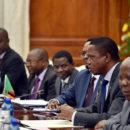Blockchain is great, but it can’t solve everything. Take conflict minerals.

Blockchain technology can help trace a product as it moves through a supply chain, but it cannot create trust where it’s often most needed.

Blockchain has been suggested as a way to avoid using minerals extracted from mines that fuel conflict or use child labour. Credit: UNMAS/Gwenn Dubourthoumieu
When it comes to solving problems today, it sometimes feels like no discussion is complete without the suggestion that blockchain technology could be the solution. In business and public services, for example, it has been promoted as a way to improve transparency, efficiency and trust. In commodity trading, where many parties are involved and goods are often sold several times, it has been celebrated a tool for reducing transaction costs. And in land administration, it has been adopted as a strategy for tackling fraud and avoiding double-ownership.
Now, many are suggesting it could be the answer to conflict minerals.
Blockchain works by using a “distributed ledger technology” whereby information is managed collectively by several users rather than just one. All changes to the database are encrypted in such a way that they cannot be altered or deleted without leaving a record of the data’s earlier state. This creates permanent and secure records which cannot be tampered with.
This technology removes opportunities for fraud, giving it obvious potential for use in tracking the origin of minerals. Strengthening the traceability of goods such as tin, wolframite, coltan and gold would help ensure their extraction is not fuelling conflict and relying on child labour. Enhancing transparency in mineral supply chains is understandably at core of the OECD 2019 Forum on responsible mineral supply chains being held this week.
In fact, the first projects using blockchain for this are under way. Anglo American Plc plans to track gemstones using the technology, while others intend to trace gold from small-scale mines. Rwanda, the world’s biggest supplier of tantalum, already launched a blockchain-based system to trace tantalum in three mines and a smelter in 2018. The government wants to disprove allegations that its commodities are blended with smuggled conflict minerals from neighbouring DRC.
Here’s how the system – created by the UK-based start-up Circulor – works in Rwanda: everyone entering a mine or selling a bag of ore has their photo taken and ID card scanned with a smartphone. The photos must match the image on file in the facial recognition system. Bags of ore are tagged with a QR code or NFC chip and scanned together with the GPS coordinates.
This tag, now registered on the ledger, allows goods to be traced as everyone in the supply chain scans the code. Along the way, third-party logistics systems can certify the product’s origin, provenance, and ethical sourcing, all recorded on the blockchain. Since a ledger entry cannot be changed unilaterally along this journey – i.e. without the permission of all other ledgers in the system – the tantalum can be traced all the way back to the mine from which it originated.
The “first mile” problem
This system may sound great, but it contains some big problems. At the heart of these is the question of trust.
The tantalum blockchain system relies on identified and trusted participants performing their allocated role on the journey. But the key weakness in the system is the point at which the ore is first registered and therefore enters the “safe space” of the ledger.
Facial recognition guarantees that the persons at this initial point (aka “the gate”) are known. However, it does not guarantee that the ore registered genuinely originates from legitimate sources. The individuals selling and registering the products can still decide to collude for a kick-back and attach the wrong tag to a batch of tantalum from a small-scale mine controlled by armed groups.
Blockchain, sadly, cannot create trust in this context. The verification mechanism depends on trust already existing. Neither facial scanning nor GPS recording guarantees where the authenticated seller got the tantalum from at this crucial first step. It cannot adjudicate on whether products first tagged as conflict-free are genuinely from a controlled and certified mine or blended with ore from other illegal mines. The consensus mechanism, which is at the heart of blockchain, adds value only once goods are already within the system. When it comes to conflict minerals, this is not where the main concern lies.
In fact, blockchain represents no progress over existing bag-and-tag traceability systems developed for the same minerals. They all rely on identifying and trusting the seller to attach a tag to the mineral, but use standard database solutions to track the flow of material through the system.
Other approaches such as analytical fingerprinting of tantalum or adding markers at the molecular level in oil and gas engage with the raw material directly. They can – in contrast to blockchain – provide the proof of origin. But they are available only for some minerals due to technological limitations. And they are more expensive.
Today, blockchain is close to the peak of the hype cycle of technologies and has generated inflated expectations. Riding this wave helps to attract publicity and funding. But while it may prove to be part of the solution to many issues, it is not necessarily to answer to every problem.







Nice blog| I have gained good knowledge about Blockchain.